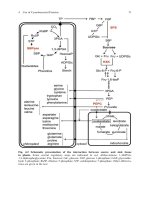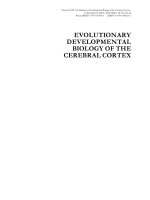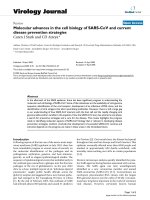Molecular biology of the cell 4th ed b alberts (garland, 2002)
Bạn đang xem bản rút gọn của tài liệu. Xem và tải ngay bản đầy đủ của tài liệu tại đây (45.88 MB, 2,396 trang )
indice
I. Introduction to the Cell
1. The Evolution of the Cell
Introduction
From Molecules to the First Cell
From Procaryotes to Eucaryotes
From Single Cells to Multicellular Organisms
References
General
Cited
2. Small Molecules, Energy, and Biosynthesis
Introduction
The Chemical Components of a Cell
Biological Order and Energy
Food and the Derivation of Cellular Energy
Biosynthesis and the Creation of Order
The Coordination of Catabolism and Biosynthesis
References
General
Cited
3. Macromolecules: Structure, Shape, and Information
Introduction
Molecular Recognition Processes
Nucleic Acids
Protein Structure
Proteins as Catalysts
References
General
Cited
4. How Cells Are Studied
file:///H|/albert/paginas/indice.htm (1 of 7) [29/05/2003 04:53:06 a.m.]
indice
Introduction
Looking at the Structure of Cells in the Microscope
Isolating Cells and Growing Them in Culture
Fractionation of Cells and Analysis of Their Molecules
Tracing and Assaying Molecules Inside Cells
References
General
Cited
II. Molecular Genetics
5. Protein Function
Introduction
Making Machines Out of Proteins
The Birth, Assembly, and Death of Proteins
References
General
Cited
6. Basic Genetic Mechanisms
Introduction
RNA and Protein Synthesis
DNA Repair
DNA Replication
Genetic Recombination
Viruses, Plasmids, and Transposable Genetic Elements
References
General
Cited
7. Recombinant DNA Technology
Introduction
The Fragmentation, Separation, and Sequencing of DNA Molecules
Nucleic Acid Hybridization
DNA Cloning
DNA Engineering
References
Cited
file:///H|/albert/paginas/indice.htm (2 of 7) [29/05/2003 04:53:06 a.m.]
indice
8. The Cell Nucleus
Introduction
Chromosomal DNA and Its Packaging
The Global Structure of Chromosomes
Chromosome Replication
RNA Synthesis and RNA Processing
The Organization and Evolution of the Nuclear Genome
References
Cited
9. Control of Gene Expression
Introduction
An Overview of Gene Control
DNA-binding Motifs in Gene Regulatory Proteins
How Genetic Switches Work
Chromatin Structure and the Control of Gene Expression
The Molecular Genetic Mechanisms That Create Specialized Cell
Types
Posttranscriptional Controls
References
General
Cited
III. Internal Organization of the Cell
10. Membrane Structure
Introduction
The Lipid Bilayer
Membrane Proteins
References
General
Cited
11. Membrane Transport of Small Molecules and the Ionic Basis of
Membrane Excitability
Introduction
Principles of Membrane Transport
Carrier Proteins and Active Membrane Transport ,
Ion Channels and Electrical Properties of Membranes
References
file:///H|/albert/paginas/indice.htm (3 of 7) [29/05/2003 04:53:06 a.m.]
indice
12. Intracellular Compartments and Protein Sorting
Introduction
The Compartmentalization of Higher Cells
The Transport of Molecules into and out of the Nucleus
The Transport of Proteins into Mitochondria and Chloroplasts
Peroxisomes
The Endoplasmic Reticulum
References
General
Cited
13. Vesicular Traffic in the Secretory and Endocytic Pathways
Introduction
Transport from the ER Through the Golgi Apparatus
Transport from the Trans Golgi Network to Lysosomes
Transport from the Plasma Membrane via Endosomes: Endocytosis
Transport from the Trans Golgi Network to the Cell Surface:
Exocytosis
The Molecular Mechanisms of Vesicular Transport and the
Maintenance of Compartmental Diversity
References
General
Cited
14. Energy Conversion: Mitochondria and Chloroplasts
Introduction
The Mitochondrion
The Respiratory Chain and ATP Synthase
Chloroplasts and Photosynthesis
The Evolution of Electron-Transport Chains
The Genomes of Mitochondria and Chloroplasts
References
General
Cited
15. Cell Signaling
Introduction
General Principles of Cell Signaling
Signaling via G-Protein-linked Cell-Surface Receptors
Signaling via Enzyme-linked Cell-Surface Receptors
Target-Cell Adaptation
The Logic of Intracellular Signaling: Lessons from Computer-based
"Neural Networks"
file:///H|/albert/paginas/indice.htm (4 of 7) [29/05/2003 04:53:06 a.m.]
indice
References
General
Cited
16. The Cytoskeleton
Introduction
The Nature of the Cytoskeleton
Intermediate Filaments
Microtubules
Cilia and Centrioles
Actin Filaments
Actin-binding Proteins
Muscle
References
General
Cited
17. The Cell-Division Cycle
Introduction
The General Strategy of the Cell Cycle
The Early Embryonic Cell Cycle and the Role of MPF
Yeasts and the Molecular Genetics of Cell-Cycle Control
Cell-Division Controls in Multicellular Animals
References
General
Cited
18. The Mechanics of Cell Division
Introduction
An Overview of M Phase
Mitosis
Cytokinesis
References
General
Cited
IV. Cells in Their Social Context
19. Cell Junctions, Cell Adhesion, and the Extracellular Matrix
Introduction
file:///H|/albert/paginas/indice.htm (5 of 7) [29/05/2003 04:53:06 a.m.]
indice
Cell Junctions
Cell-Cell Adhesion
The Extracellular Matrix of Animals
Extracellular Matrix Receptors on Animal Cells: The Integrins
The Plant Cell Wall
References
Cited
20. Germ Cells and Fertilization
Introduction
The Benefits of Sex
Meiosis
Eggs
Sperm
Fertilization
References
General
Cited
21. Cellular Mechanisms of Development
Introduction
Morphogenetic Movements and the Shaping of the Body Plan
Cell Diversification in the Early Animal Embryo ,
Cell Memory, Cell Determination, and the Concept of Positional
Values
The Nematode Worm: Developmental Control Genes and the Rules of
Cell Behavior
Drosophila and the Molecular Genetics of Pattern Formation. I.
Genesis of the Body Plan
Drosophila and the Molecular Genetics of Pattern Formation. II.
Homeotic Selector Genes and the Patterning of Body Parts ,
Plant Development
Neural Development
References
General
Cited
22. Differentiated Cells and the Maintenance of Tissues
Introduction
Maintenance of the Differentiated State
Tissues with Permanent Cells
Renewal by Simple Duplication
file:///H|/albert/paginas/indice.htm (6 of 7) [29/05/2003 04:53:06 a.m.]
indice
Renewal by Stem Cells: Epidermis ,
Renewal by Pluripotent Stem Cells: Blood Cell Formation ,
Genesis, Modulation, and Regeneration of Skeletal Muscle
Fibroblasts and Their Transformations: The Connective-Tissue Cell
Family
Appendix
References
General
Cited
23 . The Immune System
Introduction
The Cellular Basis of Immunity
The Functional Properties of Antibodies
The Fine Structure of Antibodies
The Generation of Antibody Diversity
T Cell Receptors and Subclasses
MHC Molecules and Antigen Presentation to T Cells
Cytotoxic T Cells
Helper T Cells and T Cell Activation
Selection of the T Cell Repertoire
References
General
Cited
24. Cancer
Introduction
Cancer as a Microevolutionary Process
The Molecular Genetics of Cancer
References
General
Cited
file:///H|/albert/paginas/indice.htm (7 of 7) [29/05/2003 04:53:06 a.m.]
From Procaryotes to Eucaryotes
I: Introduction to the Cell
1. The Evolution of the Cell
Introduction
From Molecules to the First Cell
From Procaryotes to Eucaryotes
From Single Cells to Multicellular Organisms
References
Introducción
From Molecules to the First Cell
Complex Chemical Systems Can Develop in an Environment That Is Far from Chemical
Equilibrium
Polynucleotides Are Capable of Directing Their Own Synthesis
Self-replicating Molecules Undergo Natural Selection
Specialized RNA Molecules Can Catalyze Biochemical Reactions
Information Flows from Polynucleotides to Polypeptides
Membranes Defined the First Cell
All Present-Day Cells Use DNA as Their Hereditary Material
Summary
Referencias
key terms
file:///H|/albert/paginas/from_procaryotes_to_eucaryotes.htm (1 of 25) [29/05/2003 04:53:10 a.m.]
From Procaryotes to Eucaryotes
Introduction
All living creatures are made of cells - small membrane-bounded compartments filled with a
concentrated aqueous solution of chemicals. The simplest forms of life are solitary cells that
propagate by dividing in two. Higher organisms, such as ourselves, are like cellular cities in
which groups of cells perform specialized functions and are linked by intricate systems of
communication. Cells occupy a halfway point in the scale of biological complexity. We study
them to learn, on the one hand, how they are made from molecules and, on the other, how they
cooperate to make an organism as complex as a human being.
All organisms, and all of the cells that constitute them, are believed to have descended from a
common ancestor cell through evolution by natural selection. This involves two essential
processes: (1) the occurrence of random variation in the genetic information passed from an
individual to its descendants and (2) selection in favor of genetic information that helps its
possessors to survive and propagate. Evolution is the central principle of biology, helping us to
make sense of the bewildering variety in the living world.
This chapter, like the book as a whole, is concerned with the progression from molecules to
multicellular organisms. It discusses the evolution of the cell, first as a living unit constructed
from smaller parts and then as a building block for larger structures. Through evolution, we
introduce the cell components and activities that are to be treated in detail, in broadly similar
sequence, in the chapters that follow. Beginning with the origins of the first cell on earth, we
consider how the properties of certain types of large molecules allow hereditary information to be
transmitted and expressed and permit evolution to occur. Enclosed in a membrane, these
molecules provide the essentials of a self-replicating cell. Following this, we describe the major
transition that occurred in the course of evolution, from small bacteriumlike cells to much larger
and more complex cells such as are found in present-day plants and animals. Lastly, we suggest
ways in which single free-living cells might have given rise to large multicellular organisms,
becoming specialized and cooperating in the formation of such intricate organs as the brain.
Clearly, there are dangers in introducing the cell through its evolution: the large gaps in our
knowledge can be filled only by speculations that are liable to be wrong in many details. We
cannot go back in time to witness the unique molecular events that took place billions of years
ago. But those ancient events have left many traces for us to analyze. Ancestral plants, animals,
and even bacteria are preserved as fossils. Even more important, every modern organism
provides evidence of the character of living organisms in the past. Present-day biological
molecules, in particular, are a rich source of information about the course of evolution, revealing
fundamental similarities between the most disparate of living organisms and allowing us to map
out the differences between them on an objective universal scale. These molecular similarities
and differences present us with a problem like that which confronts the literary scholar who
seeks to establish the original text of an ancient author by comparing a mass of variant
file:///H|/albert/paginas/from_procaryotes_to_eucaryotes.htm (2 of 25) [29/05/2003 04:53:10 a.m.]
From Procaryotes to Eucaryotes
manuscripts that have been corrupted through repeated copying and editing. The task is hard,
and the evidence is incomplete, but it is possible at least to make intelligent guesses about the
major stages in the evolution of living cells.
From Molecules to the First Cell1
Simple Biological Molecules Can Form Under
Prebiotic Conditions1,2
The conditions that existed on the earth in its first billion years are still a matter of dispute. Was
the surface initially molten? Did the atmosphere contain ammonia, or methane? Everyone seems
to agree, however, that the earth was a violent place with volcanic eruptions, lightning, and
torrential rains. There was little if any free oxygen and no layer of ozone to absorb the ultraviolet
radiation from the sun. The radiation, by its photochemical action, may have helped to keep the
atmosphere rich in reactive molecules and far from chemical equilibrium.
Simple organic molecules (that is, molecules containing carbon) are likely to have been
produced under such conditions. The best evidence for this comes from laboratory experiments.
If mixtures of gases such as CO2, CH4, NH3, and H2 are heated with water and energized by
electrical discharge or by ultraviolet radiation, they react to form small organic molecules usually a rather small selection, each made in large amounts (Figure 1-1). Among these
products are compounds, such as hydrogen cyanide (HCN) and formaldehyde (HCHO), that
readily undergo further reactions in aqueous solution (Figure 1-2). Most important,
representatives of most of the major classes of small organic molecules found in cells are
generated, including amino acids, sugars, and the purines and pyrimidines required to make
nucleotides.
Although such experiments cannot reproduce the early conditions on the earth exactly, they
make it plain that the formation of organic molecules is surprisingly easy. And the developing
earth had immense advantages over any human experimenter; it was very large and could
produce a wide spectrum of conditions. But above all, it had much more time - tens to hundreds
of millions of years. In such circumstances it seems very likely that, at some time and place,
many of the simple organic molecules found in present-day cells accumulated in high
concentrations.
Complex Chemical Systems Can Develop in an Environment
That Is Far from Chemical Equilibrium
Simple organic molecules such as amino acids and nucleotides can associate to form polymers.
file:///H|/albert/paginas/from_procaryotes_to_eucaryotes.htm (3 of 25) [29/05/2003 04:53:10 a.m.]
From Procaryotes to Eucaryotes
One amino acid can join with another by forming a peptide bond, and two nucleotides can join
together by a phosphodiester bond. The repetition of these reactions leads to linear polymers
known as polypeptides and polynucleotides, respectively. In present-day living cells, large
polypeptides - known as proteins - and polynucleotides - in the form of both ribonucleic acids
(RNA) and deoxyribonucleic acids (DNA)are commonly viewed as the most important
constituents. A restricted set of 20 amino acids constitute the universal building blocks of the
proteins, while RNA and DNA molecules are constructed from just four types of nucleotides
each. Although it is uncertain why these particular sets of monomers were selected for
biosynthesis in preference to others that are chemically similar, we shall see that the chemical
properties of the corresponding polymers suit them especially well for their specific roles in the
cell.
The earliest polymers may have formed in any of several ways - for example, by the heating of
dry organic compounds or by the catalytic activity of high concentrations of inorganic
polyphosphates or other crude mineral catalysts. Under laboratory conditions the products of
similar reactions are polymers of variable length and random sequence in which the particular
amino acid or nucleotide added at any point depends mainly on chance (Figure 1-3). Once a
polymer has formed, however, it can itself influence subsequent chemical reactions by acting as
a catalyst.
The origin of life requires that in an assortment of such molecules there must have been some
possessing, if only to a small extent, a crucial property: the ability to catalyze reactions that lead,
directly or indirectly, to production of more molecules of the catalyst itself. Production of catalysts
with this special self-promoting property would be favored, and the molecules most efficient in
aiding their own production would divert raw materials from the production of other substances.
In this way one can envisage the gradual development of an increasingly complex chemical
system of organic monomers and polymers that function together to generate more molecules of
the same types, fueled by a supply of simple raw materials in the environment. Such an
autocatalytic system would have some of the properties we think of as characteristic of living
matter: it would comprise a far from random selection of interacting molecules; it would tend to
reproduce itself; it would compete with other systems dependent on the same feedstocks; and if
deprived of its feedstocks or maintained at a wrong temperature that upsets the balance of
reaction rates, it would decay toward chemical equilibrium and "die."
But what molecules could have had such autocatalytic properties? In present-day living cells the
most versatile catalysts are polypeptides, composed of many different amino acids with
chemically diverse side chains and, consequently, able to adopt diverse three-dimensional forms
that bristle with reactive sites. But although polypeptides are versatile as catalysts, there is no
known way in which one such molecule can reproduce itself by directly specifying the formation
of another of precisely the same sequence.
Polynucleotides Are Capable of Directing Their Own
Synthesis3
Polynucleotides have properties that contrast with those of polypeptides. They have more limited
capabilities as catalysts, but they can directly guide the formation of exact copies of their own
file:///H|/albert/paginas/from_procaryotes_to_eucaryotes.htm (4 of 25) [29/05/2003 04:53:10 a.m.]
From Procaryotes to Eucaryotes
sequence. This capacity depends on complementary pairing of nucleotide subunits, which
enables one polynucleotide to act as a template for the formation of another. In the simplest case
a polymer composed of one nucleotide (for example, polycytidylic acid, or poly C) can line up the
subunits required to make another polynucleotide (in this example, polyguanylic acid, or poly G)
along its surface, thereby promoting their polymerization into poly G (Figure 1-4). Because C
subunits preferentially bind G subunits, and vice versa, the poly-G molecule in turn can promote
synthesis of more poly C.
Consider now a polynucleotide with a more complex sequence of subunits - specifically, a
molecule of RNA strung together from four types of nucleotides, containing the bases uracil (U),
adenine (A), cytosine (C), and guanine (G), arranged in some particular sequence. Because of
complementary pairing between the bases A and U and between the bases G and C, this
molecule, when added to a mixture of activated nucleotides under suitable conditions, will line
them up for polymerization in a sequence complementary to its own. The resulting new RNA
molecule will be rather like a mold of the original, with each A in the original corresponding to a U
in the copy and so on. The sequence of nucleotides in the original RNA strand contains
information that is, in essence, preserved in the newly formed complementary strands: a second
round of copying, with the complementary strand as a template, restores the original sequence
(Figure 1-5).
Such complementary templating mechanisms are elegantly simple, and they lie at the heart of
information transfer processes in biological systems. Genetic information contained in every cell
is encoded in the sequences of nucleotides in its polynucleotide molecules, and this information
is passed on (inherited) from generation to generation by means of complementary base-pairing
interactions.
Templating mechanisms, however, require additional catalysts to promote polymerization;
without these the process is slow and inefficient and other, competing reactions prevent the
formation of accurate replicas. Today, the catalytic functions that polymerize nucleotides are
provided by highly specialized catalytic proteinsthat is, by enzymes. In the "prebiotic soup"
primitive polypeptides might perhaps have provided some catalytic help. But molecules with the
appropriate catalytic specificity would have remained rare unless the RNA itself were able
somehow to reciprocate and favor their production. We shall come back to the reciprocal
relationship between RNA synthesis and protein synthesis, which is crucially important in all
living cells. But let us first consider what could be done with RNA itself, for RNA molecules can
have a variety of catalytic properties, besides serving as templates for their own replication. In
particular, an RNA molecule with an appropriate nucleotide sequence can act as catalyst for the
accurate replication of another RNA molecule - the template - whose sequence can be arbitrary.
The special versatility of RNA molecules is thought to have enabled them to play a central role in
the origin of life.
Self-replicating Molecules Undergo Natural Selection3, 4
RNA molecules are not just strings of symbols that carry information in an abstract way. They
also have chemical personalities that affect their behavior. In particular, the specific sequence of
nucleotides governs how the molecule folds up in solution. Just as the nucleotides in a
file:///H|/albert/paginas/from_procaryotes_to_eucaryotes.htm (5 of 25) [29/05/2003 04:53:10 a.m.]
From Procaryotes to Eucaryotes
polynucleotide can pair with free complementary nucleotides in their environment to form a new
polymer, so they can pair with complementary nucleotide residues within the polymer itself. A
sequence GGGG in one part of a polynucleotide chain can form a relatively strong association
with a CCCC sequence in another region of the same molecule. Such associations produce
complex three-dimensional patterns of folding, and the molecule as a whole takes on a specific
shape that depends entirely on the sequence of its nucleotides (Figure 1-6).
The three-dimensional folded structure of a polynucleotide affects its stability, its actions on other
molecules, and its ability to replicate, so that not all polynucleotide shapes will be equally
successful in a replicating mixture. Moreover, errors inevitably occur in any copying process, and
imperfect copies of the originals will be propagated. With repeated replication, therefore, new
variant sequences of nucleotides will be continually generated. Thus, in laboratory studies,
replicating systems of RNA molecules have been shown to undergo a form of natural selection in
which different favorable sequences eventually predominate, depending on the exact conditions.
Most important, RNA molecules can be selected for the ability to bind almost any other molecule
specifically. This too has been shown, in experiments in vitro that begin with a preparation of
short RNA molecules with random nucleotide sequences manufactured artificially. These are
passed down a column packed with beads to which some chosen substance is bonded. RNA
molecules that fail to bind to the chosen substance are washed through the column and
discarded; those few that bind are retained and used as templates to direct production of multiple
copies of their own sequences. This new RNA preparation, enriched in sequences that bind the
chosen substance, is then used as the starting material for a repetition of the procedure. After
several such cycles of selection and reproduction, the RNA is found to consist of multiple copies
of a relatively small number of sequences, each of which binds the test substance quite
specifically.
An RNA molecule therefore has two special characteristics: it carries information encoded in its
nucleotide sequence that it can pass on by the process of replication, and it has a specific folded
structure that enables it to interact selectively with other molecules and determines how it will
respond to the ambient conditions. These two features - one informational, the other functional are the two properties essential for evolution. The nucleotide sequence of an RNA molecule is
analogous to the genotype - the hereditary information - of an organism. The folded threedimensional structure is analogous to the phenotype - the expression of the genetic information
on which natural selection operates.
Specialized RNA Molecules Can Catalyze Biochemical
Reactions5
Natural selection depends on the environment, and for a replicating RNA molecule a critical
component of the environment is the set of other RNA molecules in the mixture. Besides acting
as templates for their own replication, these can catalyze the breakage and formation of covalent
bonds between nucleotides. For example, some specialized RNA molecules can catalyze a
change in other RNA molecules, cutting the nucleotide sequence at a particular point; and other
types of RNA molecules spontaneously cut out a portion of their own nucleotide sequence and
rejoin the cut ends (a process known as self-splicing). Each RNA-catalyzed reaction depends on
a specific arrangement of atoms that forms on the surface of the catalytic RNA molecule (the
file:///H|/albert/paginas/from_procaryotes_to_eucaryotes.htm (6 of 25) [29/05/2003 04:53:10 a.m.]
From Procaryotes to Eucaryotes
ribozyme), causing particular chemical groups on one or more of its nucleotides to become
highly reactive.
Certain catalytic activities would have had a cardinal importance in the primordial soup. Consider
in particular an RNA molecule that helps to catalyze the process of templated polymerization,
taking any given RNA molecule as template. (This ribozyme activity has been directly
demonstrated in vitro, albeit in a rudimentary form.) Such a molecule, by acting on copies of
itself, can replicate with heightened speed and efficiency (Figure 1-7A). At the same time, it can
promote the replication of any other type of RNA molecules in its neighborhood (Figure 1-7B).
Some of these may have catalytic actions that help or hinder the survival or replication of RNA in
other ways. If beneficial effects are reciprocated, the different types of RNA molecules,
specialized for different activities, may evolve into a cooperative system that replicates with
unusually great efficiency.
Information Flows from Polynucleotides to Polypeptides6
There are strong suggestions, therefore, that between 3.5 and 4 billion years ago, somewhere
on earth, self-replicating systems of RNA molecules, mixed with other organic molecules
including simple polypeptides, began the process of evolution. Systems with different sets of
polymers competed for the available precursor materials to construct copies of themselves, just
as organisms now compete; success depended on the accuracy and the speed with which the
copies were made and on the stability of those copies.
However, as we emphasized earlier, while the structure of polynucleotides is well suited for
information storage and replication, their catalytic abilities are limited by comparison with those
of polypeptides, and efficient replication of polynucleotides in modern cells is absolutely
dependent on proteins. At the origin of life any polynucleotide that helped guide the synthesis of
a useful polypeptide in its environment would have had a great advantage in the evolutionary
struggle for survival.
But how could the information encoded in a polynucleotide specify the sequence of a polymer of
a different type? Clearly, the polynucleotides must act as catalysts to join selected amino acids
together. In present-day organisms a collaborative system of RNA molecules plays a central part
in directing the synthesis of polypeptides - that is, protein synthesis - but the process is aided by
other proteins synthesized previously. The biochemical machinery for protein synthesis is
remarkably elaborate. One RNA molecule carries the genetic information for a particular
polypeptide in the form of a code, while other RNA molecules act as adaptors, each binding a
specific amino acid. These two types of RNA molecules form complementary base pairs with one
another to enable sequences of nucleotides in the coding RNA molecule to direct the
incorporation of specific amino acids held on the adaptor RNAs into a growing polypeptide chain.
Precursors to these two types of RNA molecules presumably directed the first protein synthesis
without the aid of proteins (Figure 1-7C).
Today, these events in the assembly of new proteins take place on the surface of ribosomes complex particles composed of several large RNA molecules of yet another class, together with
more than 50 different types of protein. In Chapter 5 we shall see that the ribosomal RNA in
file:///H|/albert/paginas/from_procaryotes_to_eucaryotes.htm (7 of 25) [29/05/2003 04:53:10 a.m.]
From Procaryotes to Eucaryotes
these particles plays a central catalytic role in the process of protein synthesis and forms more
than 60% of the ribosome's mass. At least in evolutionary terms, it appears to be the
fundamental component of the ribosome.
It seems likely, then, that RNA guided the primordial synthesis of proteins, perhaps in a clumsy
and primitive fashion. In this way RNA was able to create tools - in the form of proteins - for more
efficient biosynthesis, and some of these could have been put to use in the replication of RNA
and in the process of tool production itself.
The synthesis of specific proteins under the guidance of RNA required the evolution of a code by
which the polynucleotide sequence specifies the amino acid sequence that makes up the
protein. This code - the genetic code - is spelled out in a "dictionary" of three-letter words:
different triplets of nucleotides encode specific amino acids. The code seems to have been
selected arbitrarily (subject to some constraints, perhaps); yet it is virtually the same in all living
organisms. This strongly suggests that all present-day cells have descended from a single line of
primitive cells that evolved the mechanism of protein synthesis.
Membranes Defined the First Cell7
One of the crucial events leading to the formation of the first cell must have been the
development of an outer membrane. For example, the proteins synthesized under the control of
a certain species of RNA would not facilitate reproduction of that species of RNA unless they
remained in the neighborhood of the RNA; moreover, as long as these proteins were free to
diffuse among the population of replicating RNA molecules, they could benefit equally any
competing species of RNA that might be present. If a variant RNA arose that made a superior
type of enzyme, the new enzyme could not contribute selectively to the survival of the variant
RNA in its competition with its fellows. Selection of RNA molecules according to the quality of the
proteins they generated could not occur efficiently until some form of compartment evolved to
contain the proteins made by an RNA molecule and thereby make them available only to the
RNA that had generated them (Figure 1-8).
The need for containment is easily fulfilled by another class of molecules that has the simple
physicochemical property of being amphipathic, that is, consisting of one part that is hydrophobic
(water insoluble) and another part that is hydrophilic (water soluble). When such molecules are
placed in water, they aggregate, arranging their hydrophobic portions as much in contact with
one another as possible and their hydrophilic portions in contact with the water. Amphipathic
molecules of appropriate shape spontaneously aggregate to form bilayers, creating small closed
vesicles whose aqueous contents are isolated from the external medium (Figure 1-9). The
phenomenon can be demonstrated in a test tube by simply mixing phospholipids and water
together: under appropriate conditions, small vesicles will form. All present-day cells are
surrounded by a plasma membrane consisting of amphipathic molecules - mainly phospholipids in this configuration; in cell membranes, the lipid bilayer also contains amphipathic proteins. In
the electron microscope such membranes appear as sheets about 5 nm thick, with a distinctive
three-layered appearance due to the tail-to-tail packing of the phospholipid molecules.
Presumably, the first membrane-bounded cells were formed by spontaneous assembly of
file:///H|/albert/paginas/from_procaryotes_to_eucaryotes.htm (8 of 25) [29/05/2003 04:53:10 a.m.]
From Procaryotes to Eucaryotes
phospholipid molecules from the prebiotic soup, enclosing a self-replicating mixture of RNA and
other molecules. It is not clear at what point in the evolution of biological catalysts and protein
synthesis this first occurred. In any case, once RNA molecules were sealed within a closed
membrane, they could begin to evolve in earnest as carriers of genetic instructions: they could
be selected not merely on the basis of their own structure, but also according to their effect on
the other molecules in the same compartment. The nucleotide sequences of the RNA molecules
could now be expressed in the character of a unitary living cell.
All Present-Day Cells Use DNA as Their Hereditary
Material3, 6, 8
The picture we have presented is, of course, speculative: there are no fossil records that trace
the origins of the first cell. Nevertheless, there is persuasive evidence from present-day
organisms and from experiments that the broad features of this evolutionary story are correct.
The prebiotic synthesis of small molecules, the self-replication of catalytic RNA molecules, the
translation of RNA sequences into amino acid sequences, and the assembly of lipid molecules to
form membrane-bounded compartments - all presumably occurred to generate primitive cells 3.5
to 4 billion years ago.
It is useful to compare these early cells with the simplest and smallest present-day cells, the
mycoplasmas. Mycoplasmas are small bacteria of a degenerate type that normally lead a
parasitic existence in close association with animal or plant cells (Figure 1-10). Some have a
diameter of about 0.3 mm and contain only enough nucleic acid to direct the synthesis of about
400 different proteins. Some of these proteins are enzymes, some are structural; some lie in the
cell's interior, others are embedded in its membrane. Together they synthesize essential small
molecules that are not available in the environment, redistribute the energy needed to drive
biosynthetic reactions, and maintain appropriate conditions inside the cell.
The first cells on the earth were presumably less sophisticated than a mycoplasma and less
efficient in reproducing themselves. There was, however, a more fundamental difference
between these primitive cells and a mycoplasma, or indeed any other present-day cell: the
hereditary information in all cells alive today is stored in DNA rather than in the RNA that is
thought to have stored the hereditary information during the earliest stages of evolution. Both
types of polynucleotides are found in present-day cells, but they function in a collaborative
manner, each having evolved to perform specialized tasks. Small chemical differences fit the two
kinds of molecules for distinct functions. DNA acts as the permanent repository of genetic
information, and, unlike RNA, it is found in cells principally in a double-stranded form, composed
of a pair of complementary polynucleotide molecules. This double-stranded structure makes
DNA in cells more robust and stable than RNA; it also makes DNA relatively easy to replicate (as
will be explained in Chapter 3) and permits a repair mechanism to operate that uses the intact
strand as a template for the correction or repair of the associated damaged strand. DNA guides
the synthesis of specific RNA molecules, again by the principle of complementary base-pairing,
though now this pairing is between slightly different types of nucleotides. The resulting singlestranded RNA molecules then perform two primeval functions: they direct protein synthesis both
as coding RNA molecules (messenger RNAs) and as RNA catalysts (ribosomal and other
nonmessenger RNAs).
file:///H|/albert/paginas/from_procaryotes_to_eucaryotes.htm (9 of 25) [29/05/2003 04:53:10 a.m.]
From Procaryotes to Eucaryotes
The suggestion, in short, is that RNA preceded DNA in evolution, having both genetic and
catalytic properties; eventually, DNA took over the primary genetic function and proteins became
the major catalysts, while RNA remained primarily as the intermediary connecting the two
(Figure 1-11). With the advent of DNA cells were enabled to become more complex, for they
could then carry and transmit an amount of genetic information greater than that which could be
stably maintained in RNA molecules.
Summary
Living cells probably arose on earth about 3.5 billion years ago by spontaneous reactions
between molecules in an environment that was far from chemical equilibrium. From our
knowledge of present-day organisms and the molecules they contain, it seems likely that the
development of the directly autocatalytic mechanisms fundamental to living systems began with
the evolution of families of RNA molecules that could catalyze their own replication. With time,
one of these families of cooperating RNA catalysts developed the ability to direct synthesis of
polypeptides. Finally, as the accumulation of additional protein catalysts allowed more efficient
and complex cells to evolve, the DNA double helix replaced RNA as a more stable molecule for
storing the increased amounts of genetic information required by such cells.
Figure 1-1. A typical experiment simulating conditions on the primitive earth. Water is heated in a
closed apparatus containing CH4, NH3, and H2, and an electric discharge is passed through the
vaporized mixture. Organic compounds accumulate in the U-tube trap.
file:///H|/albert/paginas/from_procaryotes_to_eucaryotes.htm (10 of 25) [29/05/2003 04:53:10 a.m.]
From Procaryotes to Eucaryotes
Figure 1-2. A few of the compounds that might form in the experiment described in Figure 1-1.
Figure 1-3. Formation of polynucleotides and polypeptides. Nucleotides of four kinds (here
represented by the single letters A, U, G, and C) can undergo spontaneous polymerization with
the loss of water. The product is a mixture of polynucleotides that are random in length and
sequence. Similarly, amino acids of different types, symbolized here by three-letter abbreviated
names, can polymerize with one another to form polypeptides. Present-day proteins are built
from a standard set of 20 types of amino acids.
file:///H|/albert/paginas/from_procaryotes_to_eucaryotes.htm (11 of 25) [29/05/2003 04:53:10 a.m.]
From Procaryotes to Eucaryotes
Figure 1-4. Polynucleotides as templates. Preferential binding occurs between pairs of
nucleotides (G with C and U with A) by relatively weak chemical bonds (above). This pairing
enables one polynucleotide to act as a template for the synthesis of another (left).
Figure 1-5. Replication of a polynucleotide sequence (here an RNA molecule). In step 1 the
original RNA molecule acts as a template to form an RNA molecule of complementary sequence.
In step 2 this complementary RNA molecule itself acts as a template, forming RNA molecules of
the original sequence. Since each templating molecule can produce many copies of the
complementary strand, these reactions can result in the "multiplication" of the original sequence.
file:///H|/albert/paginas/from_procaryotes_to_eucaryotes.htm (12 of 25) [29/05/2003 04:53:10 a.m.]
From Procaryotes to Eucaryotes
Figure 1-6. Conformation of an RNA molecule. Nucleotide pairing between different regions of
the same polynucleotide (RNA) chain causes the molecule to adopt a distinctive shape.
Figure 1-7. Three successive steps in the evolution of a self-replicating system of RNA
molecules capable of directing protein synthesis.
file:///H|/albert/paginas/from_procaryotes_to_eucaryotes.htm (13 of 25) [29/05/2003 04:53:10 a.m.]
From Procaryotes to Eucaryotes
Figure 1-8. Evolutionary significance of cell-like compartments. In a mixed population of selfreplicating RNA molecules capable of influencing protein synthesis (as illustrated in Figure 1-7),
any improved form of RNA that is able to promote formation of a more useful protein must share
this protein with its neighboring competitors. However, if the RNA is enclosed within a
compartment, such as a lipid membrane, then any protein the RNA causes to be made is
retained for its own use; the RNA can therefore be selected on the basis of its guiding production
of a better protein.
Figure 1-9. Formation of membranes by phospholipids. Because these molecules have
hydrophilic heads and lipophilic tails, they will align themselves at an oil-water interface with their
heads in the water and their tails in the oil. In water they will associate to form closed bilayer
vesicles in which the lipophilic tails are in contact with one another and the hydrophilic heads are
exposed to the water.
file:///H|/albert/paginas/from_procaryotes_to_eucaryotes.htm (14 of 25) [29/05/2003 04:53:10 a.m.]
From Procaryotes to Eucaryotes
Figure 1-10. Spiroplasma citrii, a mycoplasma that grows in plant cells. (Courtesy of Jeremy
Burgess.)
Figure 1-11. Suggested stages of evolution from simple self-replicating systems of RNA
molecules to present-day cells. Today, DNA is the repository of genetic information and RNA
acts largely as a go-between to direct protein synthesis.
References
General
file:///H|/albert/paginas/from_procaryotes_to_eucaryotes.htm (15 of 25) [29/05/2003 04:53:10 a.m.]
From Procaryotes to Eucaryotes
Bendall, D.S., ed. Evolution from Molecules to Men. Cambridge, UK: Cambridge University
Press, 1983.
Evolution of Catalytic Function. Cold Spring Harbor Symp. Quant. Biol. 52,: 1987..
Curtis, H.; Barnes, N.S. Biology, 5th ed. New York: Worth, 1989.
Darnell, J.E.; Lodish, H.F.; Baltimore, D. Molecular Cell Biology, 2nd ed., Chapter 26. New York:
Scientific American Books, 1990.
Darwin, C. On the Origin of Species. London: Murray, 1859. Reprinted, New York: Penguin,
1984.
Dawkins, R. The Blind Watchmaker. New York: Viking Penguin, 1988.
Margulis, L.M.; Schwartz, K.V. Five Kingdoms: An Illustrated Guide to the Phyla of Life on Earth,
2nd ed. New York: W.H. Freeman, 1988.
Watson, J.D.; Hopkins, N.H.; Roberts, J.W.; Steitz, J.A.; Weiner, A.M. Molecular Biology of the
Gene, 4th ed., Chapter 28. Menlo Park, CA: Benjamin-Cummings, 1987.
Cited
1. Lazcano, A.; Fox, G.E.; Oró, J.F. Life before DNA: the origin and evolution of early archaean
cells. In The Evolution of Metabolic Function (R.P. Mortlock, ed.), pp. 237-295. Boca Raton, FL:
CRC Press, 1992.
Schopf, J.W.; Hayes, J.M.; Walter, M.R. Evolution of earth's earliest ecosystems: recent
progress and unsolved problems. In Earth's Earliest Biosphere: Its Origin and Evolution (J.W.
Schopf, ed.), pp. 361-384. Princeton, NJ: Princeton University Press, 1983.
2. Miller, S.L. Which organic compounds could have occurred on the prebiotic earth? Cold
Spring Harbor Symp. Quant. Biol. 52: 17-27. 1987. (PubMed)
3. Orgel, L.E. Molecular replication. Nature 358: 203-209. 1992. (PubMed)
4. Ellington, A.D.; Szostak, J.W. In vitro selection of RNA molecules that bind specific ligands.
Nature 346: 818-822. 1990. (PubMed)
Joyce, G.F. Directed molecular evolution. Sci. Am. 267(6): 90-97. 1992. (PubMed)
5. Bartel, D.P.; Szostak, J.W. Isolation of new ribozymes from a large pool of random
file:///H|/albert/paginas/from_procaryotes_to_eucaryotes.htm (16 of 25) [29/05/2003 04:53:10 a.m.]
From Procaryotes to Eucaryotes
sequences. Science 261: 1411-1418. 1993. (PubMed)
Cech, T.R. RNA as an enzyme. Sci. Am. 255(5): 64-75. 1986. (PubMed)
6. Alberts, B.M. The function of the hereditary materials: biological catalyses reflect the cell's
evolutionary history. Am. Zool. 26: 781-796. 1986.
Maizels, N.; Weiner, A.M. Peptide-specific ribosomes, genomic tags, and the origin of the
genetic code. Cold Spring Harbor Symp. Quant. Biol. 52: 743-749. 1987. (PubMed)
7. Cavalier-Smith, T. The origin of cells: a symbiosis between genes, catalysts, and membranes.
Cold Spring Harbor Symp. Quant. Biol. 52: 805-824. 1987. (PubMed)
8. Muto, A.; Andachi, Y.; Yuzawa, H.; Yamao, F.; Osawa, S. The organization and evolution of
transfer RNA genes in Mycoplasma capricolum. Nucl. Acid Res. 18: 5037-5043. 1990.
9. Sogin, M.L. Early evolution and the origin of eukaryotes. Curr. Opin. Genet. Devel. 1: 457-463.
1991.
Vidal, G. The oldest eukaryotic cells. Sci. Am. 250(2): 48-57. 1984. (PubMed)
10. Woese, C.R. Bacterial evolution. Microbiol. Rev. 51: 221-271. 1987. (PubMed)
Zillig, W. Comparative biochemistry of Archaea and Bacteria. Curr. Opin. Genet. Devel. 1: 544551. 1991.
11. Clarke, P.H. Enzymes in bacterial populations. In Biochemical Evolution (H. Gutfreund, ed.),
pp. 116-149. Cambridge, UK: Cambridge University Press, 1981.
De Duve, C. Blueprint for a Cell: The Nature and Origin of Life. Burlington, NC: Neil Patterson
Publishers, 1991.
12. Li, W.-H.; Graur, D. Fundamentals of Molecular Evolution. Sunderland, MA: Sinauer
Associates, 1991.
Sidow, A.; Bowman, B.H. Molecular phylogeny. Curr. Opin. Genet. Devel. 1: 451-456. 1991.
13. Dickerson, R.E. Cytochrome c and the evolution of energy metabolism. Sci. Am. 242(3): 136153. 1980.
14. Cavalier-Smith, T. The origin of eukaryote and archaebacterial cells. Ann. N.Y. Acad. Sci.
503: 17-54. 1987. (PubMed)
14. Gray, M.W. The evolutionary origins of organelles. Trends Genet. 5: 294-299. 1989.
(PubMed)
Margulis, L. Symbiosis in Cell Evolution. New York: W.H. Freeman, 1981.
15. Gray, M.W. Origin and evolution of mitochondrial DNA. Annu. Rev. Cell Biol. 5: 25-50. 1989.
(PubMed)
file:///H|/albert/paginas/from_procaryotes_to_eucaryotes.htm (17 of 25) [29/05/2003 04:53:10 a.m.]
From Procaryotes to Eucaryotes
Sogin, M.L.; Gunderson, J.H.; Elwood, H.J.; Alonso, R.A.; Peattie, D.A. Phylogenetic meaning of
the kingdom concept: an unusual ribosomal RNA from Giardia lamblia. Science 243: 75-77.
1989. (PubMed)
Vossbrinck, C.R.; Maddox, J.V.; Friedman, S.; Debrunner-Vossbrinck, B.A.; Woese, C.R.
Ribosomal RNA sequence suggests microsporidia are extremely ancient eukaryotes. Nature
326: 411-414. 1987. (PubMed)
16. Bryant, D.A. Puzzles of chloroplast ancestry. Curr. Biol. 2: 240-242. 1992.
17. Sleigh, M.A. Protozoa and Other Protists. London: Edward Arnold, 1989.
18. Buchsbaum, R. Animals Without Backbones, 3rd ed. Chicago: University of Chicago Press,
1987.
Field, K.G. Molecular phylogeny of the animal kingdom. Science 239: 748-753. 1988. (PubMed)
Knoll, A.H. The end of the proterozoic eon. Sci. Am. 265(4): 64-73. 1991. (PubMed)
Levinton, J.S. The big bang of animal evolution. Sci. Am. 267(5): 84-91. 1992. (PubMed)
Shapiro, J.A. Bacteria as multicellular organisms. Sci. Am. 258(6): 82-89. 1988.
Valentine, J.W. The evolution of multicellular plants and animals. Sci. Am. 239(3): 140-158.
1978. (PubMed)
19. Bode, P.M.; Bode, H.R. Patterning in Hydra. In Pattern Formation (G.M. Malacinski, S.V.
Bryant, eds.), pp. 213-244. New York: Macmillan, 1984.
20. Raff, R.A.; Kaufman, T.C. Embryos, Genes, and Evolution. New York: Macmillan, 1983.
Slack, J.M.W.; Holland, P.W.H.; Graham, C.F. The zootype and the phylotypic stage. Nature
361: 490-492. 1993. (PubMed)
21. Chothia, C. One thousand families for the molecular biologist. Nature 357: 543-544. 1992.
(PubMed)
Miklos, G.L.; Campbell, H.D. The evolution of protein domains and the organizational
complexities of metazoans. Curr. Opin. Genet. Devel. 2: 902-906. 1992.
Key terms
•
Amino Acids
•
Biogenesis*
file:///H|/albert/paginas/from_procaryotes_to_eucaryotes.htm (18 of 25) [29/05/2003 04:53:10 a.m.]









